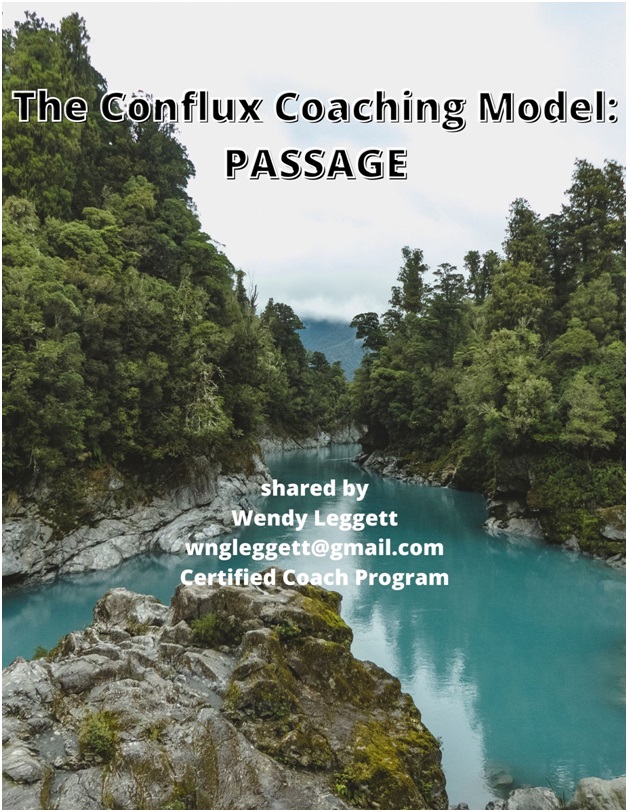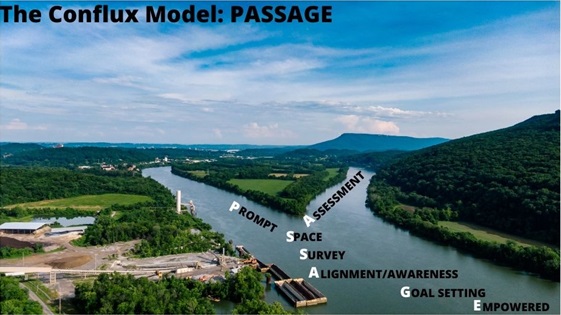A Coaching Model Created by Wendy Leggett
(Business Coach, UNITED STATES)
 Conflux Professional Coaching
Conflux Professional Coaching
Growth entails transitions of your mindset. When you outgrow a view of reality, some aspects of your way of life lose relevance. They become dissatisfying highlights of the need for a better way.
The beauty lies in the new paths that appear with your transition. The new goals and desires, fueled by an intuitive wish to compete with yourself and continue your journey of self-improvement.― Innocent Mwatsikesimbe
Throughout our lives, we face events, circumstances, and situations that signify change. To the eye, the outcome appears external -whether it’s the start of a new career, the birth of a child, retiring from the job market, moving one’s place of residence, and so on. Upon taking a closer look at the individual, however, we recognize that the impact goes much deeper, affecting the inner workings of that whole being as well. To one who is aware, this point of passage and its effect on the internal and external self constitute a transition. To one who is open to the opportunity and the challenge, this time can result in learning and growth.

[1]The best part of your story is when it changes.― Bella Bloom
Coaching Niche
My Coaching Niche focuses on individuals in transition; when the catalyst of change ignites an exploration of possibilities. My Coaching approach builds on the premise that, when such change occurs, we face a pivotal time. If we’re aware and open, we can take this opportunity for a merge to take place, a Conflux of Self. We can pause, assess, and evaluate where we’ve been and, prompted by this change, where we are now going. We can give space to this time of change, allowing for reflection, reassessment, and reorientation before we embark on our new path. In this way, as we face the change, our focus begins with exploring the meaning of that change and remembrance and recognition of our past self and experiences that might inform or impact our forward movement. After this self-inventory, we can carry forward those qualities that will serve us and combine them with the vision we have for our future self as we enter into our new situation or circumstance. It’s like two rivers coming together, a Conflux. In merging the best of our past self and plans for our future self, just as the rivers joining, the channel is more substantial, deeper, and ever forward. By embarking on this merge, we’ll successfully navigate the potentially turbulent waters of a transition, flowing into a more powerful, meaningful life experience.
How strange that the nature of life is change, yet the nature of human beings is to resist change. And how ironic that the difficult times we fear might ruin us are the very ones that can break us open and help us blossom into who we were meant to be.― Elizabeth Lesser
The Strength of the Conflux Model
A transition can present a time of instability, unknowns, emotional upheaval, and/or confusion. The Conflux Model supports the Client in a myriad of ways: providing a sounding board resulting in the release of non-supportive thoughts and an opportunity to refocus; the chance to let go by uncovering limiting beliefs or a fixed mindset; an invitation to look at one’s strengths and values through exploration and discovery; an opportunity to gain clarity around, and commitment to one’s vision and goals; a pathway to achieve those goals through clear, actionable steps.
By not giving time and attention to both the external and internal impacts of a change in circumstance, situation, or status, an individual may miss growth opportunities, repeat dysfunctional patterns, and continue with outdated beliefs. The concept that when facing change, one is facing a crossroads, may perpetuate this approach. One day we’re moving forward; the next day, we’re jagging to the right or the left. If left unquestioned or unattended, the change can feel abrupt, black-or-white, taking all with, or leaving all behind, and moving on a very different path. Instead, the Conflux model recognizes the value we bring to the point of the change. It instills the importance of reflecting on what parts of our past will serve us on our path as we move forward. That awareness, coupled with an exploration of the change’s impact before moving forward, provides knowledge and clarity of thought. This clarity will inform and guide the individual about their vision for the future and those actions needed to accomplish their goals. One can then realize a successful transition and understand how to navigate future transitions.
… change emphasizes what is happening TO us while transition emphasizes the opportunity for growth within.― William Bridges, Managing Transitions
Approach
When a client is experiencing a change in their life, the support of the Coaching space can provide numerous benefits:
 The Conflux Model: PASSAGE
The Conflux Model: PASSAGE
The framework employed in the session embraces the concept of transition as a time of passage:
P=Prompt(Event, Circumstance, Situation that opens the dialogue)
A=Assessment(Self Inventory: What is ending &needs letting go of; what serves to carry forward)
S=Space(Reflection: What rituals, thinking, actions need to take place to clear the path to move ahead)
S= Survey(Who Am I; What Do I Want)
A=Alignment; Awareness (Do these choices align with my Values; Does this match with my Purpose; Do I have what I need to move forward)
G=Goal Setting(This is what I want; this is how I’ll achieve it)
E= Empowered(Acknowledge & Celebrate my ability to accomplish my vision)
Just as a River flows, the Client sessions too will focus on forwarding movement. A part of this is referencing the past in the context of the intent for growth, learning, and change. The path won’t always be smooth or linear as merging former and future selves evolve. However, the outcome will be a richer, more profound awareness and acceptance of what is and a purpose and plan for what can be.
[1] Narender9, Confluence of Zansakr and Indus River, Sept 24, 2014, Nimmu near LEH in Ladakh, India.